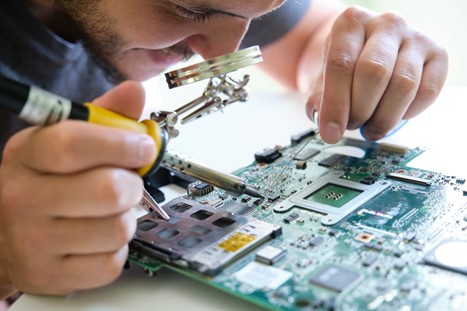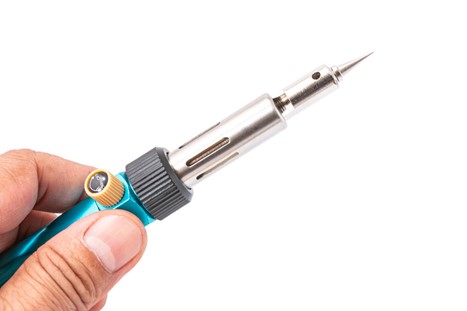Soldering 101: How Long Do Soldering Tips Last?

Soldering tips are essential for performing any soldering task successfully. Once you begin soldering, it’s common to wonder about their longevity, which is why we often get asked this all-important question: How long do soldering tips last?
Well, the answer is that it depends on a variety of things. Truthfully, there is no set amount of time for tips to expire. However, this does bring up another common concern. How to make a soldering tip last as long as possible. Fortunately, there are a number of things you can do to extend the life of soldering tips.
Solder Quality Matters
Choosing solder may sometimes seem like it’s not a big deal but, actually, it does matter what type of solder you use. Solder quality ranges from adequate to high, and when you want to protect your tips, always go for the highest quality solder you can comfortably afford. The reason why is because low-quality solder contains impurities that can build up on the tip, making it more difficult to work with over time.Alternatively, quality solder always melts effortlessly when it reaches an optimized temperature. For instance, a 60/40 lead/tin solder, should melt easily at a temperature of 460 degrees Fahrenheit. Meanwhile, a low-quality solder may only partially melt at this temperature. Read manufacturer details about solder to get more information about its performance.
Optimize Temperature
Take care to heat your soldering tips to the best optimal temperature for that particular tip. Overheating tips can lead to their early burnout due to damage. The temperature sensor of your soldering station can help you keep track of optimal heat. Resist the temptation to raise the heat higher than needed when the tip temperature naturally decreases while in use. Also, get in the habit of reducing the temperature to the “idle” setting or turning the unit off when the tip isn’t being used.
Keep Tips Clean
Regular cleaning of your tips can help extend their life. Clean tips also give you peak performance. Before each use, you can remove corrosion, grease, and oxidation with alcohol and a clean cloth. Avoid cleaning tips with a damp or wet sponge. Constant wetness can lead to tip metal fatigue or failure.Metal wool (made of brass or stainless steel) is another reliable and safe way to clean soldering tips. Soldering iron tip cleaners make cleaning easier.
Be Careful With Flux
Flux is a cleaning substance prized for its ability to remove oxidation from metal. It is often used during soldering to keep tips clean. Even so, caution should be taken when using flux because dipping tips into it can cause corrosion. Water-soluble flux can lead to damaged tips once tips reach a high temperature. It is best to avoid cleaning tips with flux, but it can be useful in some cases. If you do use it, be sure to get rid of all excess flux from the tip by thoroughly cleaning it afterwards.Protect Tips With Tinning
Tinning is an easy method that can protect your tips from the dreaded oxidization. It also makes soldering easier. Do the following:- Clean the tip
- Coat the tip with a small amount of tip tinner
- Clean and tin your tips after working a few joints
- Wipe the tip clean after you’re done and turn the unit off
Storing Tips
Proper storage methods can keep tips in good shape for longer.In the iron. Prevent tip seizing by loosening the screw that holds the tip in place.
Outside the iron. After tips cool, store tips in a well-sealed bag, case, or container.
Tags
Q Source
Guest Blog
ESD
My Account
Web account
Transforming Technologies
bevco
guest blog
signs
wish lists
search history
Bevco
ANSI/ESD
importance of ergonomics
us made
healthy
ergonomics
easy assembly
q source
40
celebrates
blog tools
composite decking
decking
bench magnifier
vision engineering
vision luxo
file
attachments
upload
attach files
purchase order
tax exempt form
account holder
social distancing
employee safety
customer safety
metcal introducing gt90 and gt120
unitron
track orders
re-order
holiday
July 4th
office closure
Independence Day
QSource.com
wastebaskets
PCBs
ANSI/ESD S2020
workstations
conductive
static dissipative
Brady
arc flash
pipe markers
labels
lockout
tagout
self adhesive
identification
ASG
Jergens
torque
threaded fasteners
ISO 5393
NIST
35th
anniversary
1984
customer service
Q Electronics
Steve Quail
Gus Lugten
industrial assembly
production
miscellaneous
Web site
features
order templates
express checkout
quick order
company logos
Simonds
ergonomic tools
cutters
crimpers
pneumatic
Shopping Tools
favorites
frequent orders
checkout defaults
carts
Atrix
Omega
cordless vacuum
immediate containment
promo
ULPA
SMTA
Long Island
workshop
Deadly Sins of SMT
Phil Zarrow
assembly process
stereo microscope
On the Bench
how-to
focus
Unitron
Peter Indrigo
video
Z10 Series
eyestrain
ergonomic seating
musculoskeletal disorders
Department of Labor
National Research Council
National Safety Council
soldering
comic books
smt
surface mount technology
Mighty Ohm
Silicon Farmers
Mitch Altman
Andie Nordgren
Jeff Keyzer
Greg Peek
Dave Roberts
Nitrile
allergies
latex
rubber gloves
TechNiGlove
Fritz Maskrey
Type 4
disposable gloves
4500 Series
rubber table mats
free shipping
static control
order tracking
recent web orders
user info
shopping tools
account tools
backless stools
ErgoLux
ErgoLux Jr
Versa
Maintenance Repair
ANSI-BIFMA
Greenguard Gold
lab
medical
cleanroom
industrial
electronic assembly
quotes
orders
shopping
Quantum Storage Systems
Free Shipping
Bins
Totes
Carts
Shelving
Static Solutions
hand lotion
EOS/ESD
personal grounding
wrist straps
heel grounders
Craig Zander
Walking Voltage Test
flooring
footwear
Warmbier
WT5000
EFM51WT
web account
nitrile gloves
Show All
Posts
2024
April
2023
2022
2021
The Ultimate Guide to Selecting the Right Industrial Equipment for Your Business
[04/02/24 10:15 AM]
February
Bevco - Importance of Ergonomics in Seating
[02/27/24 11:27 AM]
The Bevco Difference
[02/22/24 02:52 PM]
January
October
September
2020
Magnifying Glass Strength and What it Means
[09/15/21 10:03 AM]
Steps on How to Desolder a Keyboard
[09/01/21 10:39 AM]
August
What Is the Best Conductive Ink Pen for 2021?
[08/18/21 10:58 AM]
Tips on How to Find and Where to Use ESD Floor Products
[08/10/21 02:39 PM]
Quick Guide: What Is a Dial Test Indicator Used For?
[08/04/21 12:00 AM]
July
What Is an SMD Rework Station and How Does it Work?
[07/28/21 02:25 PM]
Quick Guide: How to Use ESD Mats and Wrist Straps
[07/14/21 12:05 PM]
June
All About Static Shielding and Static-Shielding Bags
[06/30/21 12:42 PM]
Conductive Ink: 5 Conductive Ink Uses for Modern Industry
[06/16/21 10:42 PM]
Soldering 101: How Long Do Soldering Tips Last?
[06/02/21 02:39 PM]
May
Industrial Needles: How Do I Choose A Needle Gauge?
[05/20/21 08:43 AM]
Guide to the Best SMD Rework Stations of 2021
[05/05/21 12:10 PM]
March
November
2019
How to Wash Clean Room Garments
[11/12/20 12:00 AM]
The Smallest Hot Air Rework Station on the Market
[11/04/20 01:21 PM]
October
The Best Stereo and Zoom Microscopes Available Today
[10/29/20 08:51 AM]
Office Floor Marking Tape for Social Distancing
[10/21/20 02:41 AM]
Top 5 Uses for LED Magnifying Lamps
[10/15/20 12:22 AM]
August
How to Choose The Best Magnifying Task Lamp
[08/26/20 11:32 AM]
Helping the Pharmaceutical Industry
[08/19/20 09:26 AM]
Moisture Barrier Bags, Desiccant and Humidity Indicator Cards
[08/17/20 12:58 PM]
How Q Source Can Help The Electronic Industry
[08/12/20 02:25 PM]
Tips on How To Best Organize Your Warehouse
[08/05/20 09:39 AM]
July
Social Distancing Products for Businesses
[07/29/20 05:14 PM]
A Guide to Gloves
[07/22/20 09:01 AM]
How to choose the right ESD Bag
[07/21/20 12:02 AM]
When and How to Properly Use Face Masks
[07/15/20 02:23 PM]
What is Dwell Time? Tips for Disinfecting Surfaces
[07/09/20 05:49 AM]
June
MetCal -GT-90 and GT-120
[06/23/20 10:10 AM]
Defining ESD Protective Packaging Requirements
[06/22/20 10:28 AM]
Differences Between Cleaning, Sanitizing, & Disinfecting
[06/19/20 12:49 PM]
How to Maintain a Virus-Free Work Environment
[06/17/20 11:17 AM]
Ergonomic Safety & Microscopes: Unitron Offers a Solution
[06/01/20 04:11 PM]
April
March
Differences Between Brazing, Soldering, and Welding
[03/09/20 09:11 AM]
Guide to Soldering: How to Use a Soldering Iron
[03/06/20 04:00 PM]
Guide to Cleanroom Classifications & Standards
[03/06/20 11:26 AM]
How to Clean a Circuit Board - A Q Source Guide
[03/05/20 11:54 AM]
Electrostatic discharge -ESD
[03/04/20 05:34 PM]
Guide to ESD vs. Anti-Static Work Safety Wear
[03/04/20 05:00 PM]
How to Use Tip Tinner - 6 Easy Steps - Q Source
[03/04/20 09:11 AM]
January
December
October
2018
Vision-Engineering-Guest-Blog-Lean-Mfg
[10/14/19 02:42 PM]
Vision Engineering - Guest Blog - Stereo Microscope
[10/03/19 12:31 AM]
September
July
Managing Your Q Source Web Orders
[07/11/19 09:32 AM]
Celebrating the Red, White & (Q) Blue - Q Source Will Be Closed on July 4th & 5th in Honor of Independence Day
[07/03/19 12:55 PM]
June
ESD Wastebaskets: An Overlooked Necessity for Your Workstation Environment
[06/26/19 12:48 PM]
Signs, Signs, Everywhere There's Signs...and Labels, Ribbons & More
[06/21/19 10:54 AM]
A How-To for Determining Torque Requirements for Threaded Fasteners - Guest Blog
[06/18/19 04:20 PM]
Celebrating 35 Years of Providing Best Value and Better Service for Our Customers
[06/13/19 09:50 AM]
Q Source My Account Focus: Miscellaneous Web Site Features
[06/12/19 11:48 AM]
Q Source Adds Global Pneumatic Tools Leader Simonds Inc.'s Cutting & Crimping Products to Lineup
[06/04/19 05:19 PM]
Favorites, Wish Lists & More: A Closer Look at Your My Account Shopping Tools
[06/03/19 11:21 AM]
May
Get a Free Extra Battery w/Atrix' New Omega Cordless Immediate Containment Vacuum
[05/29/19 12:13 PM]
Long Island SMTA Workshop to Discuss the "Deadly Sins" of SMT
[05/28/19 11:22 AM]
How to Properly Focus a Stereo Microscope - "On the Bench" Series
[05/17/19 04:02 PM]
Ergonomic Seating: Good for the Body and the Wallet – Guest Blog
[05/16/19 12:06 PM]
Soldering Comic Books Bring How-To Knowledge to a Wide Audience
[05/14/19 10:19 AM]
Accelerator-Free Nitrile to the Rescue! TechNiGlove International's Fight Against Nitrile Allergy - Guest Blog
[05/09/19 11:16 AM]
April
Free Shipping on Select Transforming Technologies 4500 Series ESD Rubber Table Mats
[04/29/19 12:46 PM]
Learn How to Get the Most Out of Your Q Source Web Account
[04/29/19 09:54 AM]
Q Source's Mobile Apps for iOS and Android Devices
[04/18/19 10:21 AM]
Bevco Backless Stools: All-Around Reliability for a Variety of Applications
[04/09/19 01:07 PM]
Create Your Q Source Web Account Today: Discover the Great Features & Benefits
[04/09/19 10:35 AM]
March
Free Shipping on Quantum Storage Systems Products
[03/29/19 09:42 AM]
Static Solutions ESD Hand Lotions Help Fight Potential Static Damage - Guest Blog
[03/22/19 12:55 PM]
Is Your ESD Flooring and Footwear System Working? – Guest Blog
[03/20/19 12:55 PM]
Q Source Web Account Benefits & Features
[03/15/19 03:05 PM]
February

